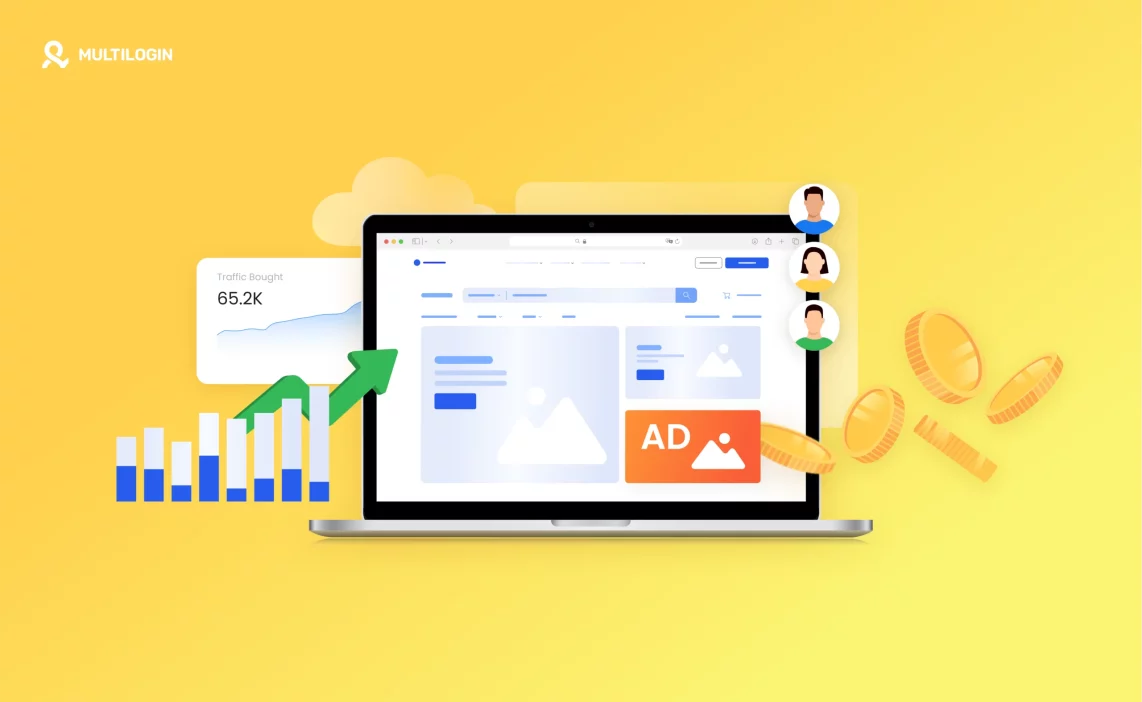Buying a pre-built dropshipping store can fast-track your career in ecommerce. These sites are often described as a “turnkey dropshipping store.” Sellers pitch that you can buy a store and make money instantly.
Now, it is possible to succeed when you buy a dropshipping store. But it takes a lot of hard work, and you need a plan to scale. If you don’t plan for sustainable growth, you may find that everything falls apart when you start making sales.
In this guide, we’ll reveal how you can scale a dropshipping business fast. You’ll learn the growth tactics and the processes you need. Let’s get started.
1. Find suppliers that can scale with you
When you buy a pre-built website from an exchange, dropshipping stores usually have existing suppliers the previous owner used to fulfill customer orders. Before you can scale, you need to know whether these suppliers can handle a large volume of orders.
If suppliers can’t keep up, you’ll find yourself dealing with upset customers wanting to find out why it is taking so long for their orders to arrive. Orders need to be shipped on time and contain exactly what the customer ordered.
It’s a good idea to order sample products from your suppliers to judge the product quality and service for yourself. You can also reach out to the supplier to see how comfortable they are processing larger amounts of orders.
If the supplier is on AliExpress, you can also check their customer feedback and view the number of orders they’ve processed.
2. Test new products
You’ll need to diversify your range and find in-demand products to scale quickly.
Many dropshipping businesses see fast growth early. But this levels off when they reach a saturation point. Being too reliant on a single product is a significant risk.
If a competitor can source the product cheaper or customer demand drops, your sales will collapse.
One of the key benefits of the dropshipping business model is that you don’t need to invest heavily in inventory. Instead, you can test demand for products with minimal risk.
You can add new products to your store and place a few ads to gauge interest. Then, if a product sells, you can increase your marketing budget to drive more sales.
3. Consider private label products
Private label products are the natural next step for successful dropshipping stores. Instead of selling third-party products, you can create your own branded products.
Your supplier still handles the fulfillment process, but your brand logo appears on the label, packaging, etc.
In 2021, 25% of shoppers purchased products from a private label brand.
Private labeling can help you stand out from your competitors. It often means you can charge a higher price for your products and increase your margins. It also makes your store more memorable.
4. Prepare for the holiday season
The holidays are the peak sales season for many dropshipping stores. In some niches, stores make most of their revenue in only a few short months.
In 2022, US ecommerce holiday sales are set to total more than $224 billion, a 6.1% increase on 2021.
If your new store is seasonal, you need to know when to expect high order volumes. This will help you plan and ramp up your marketing campaigns when they are most impactful.
One of the most effective ways to drive impulse buys during the holidays is to create a sense of urgency. For example, you can use limited-time flash sales and pop-ups showing recent purchases to encourage shoppers to click “Buy Now.”
5. Outsource
Outsourcing can be an effective way to help your business navigate growth stages. Aside from the time-saving benefits, hiring a third party to handle some aspects of your business can boost performance.
For example, you might be an expert at setting up Facebook Ads campaigns but need help writing the copy for your ads. Hiring a specialist could improve your ad copy and free you up to focus on things you’re good at.
If you find specific tasks challenging, they will only get more difficult as you scale.
Identify the tasks that you struggle with and would most benefit from outsourcing. Then, look into hiring a freelancer or third party to help you.
6. Automate time-consuming tasks
Some dropshipping tasks can be automated rather than outsourced. Dropshipping automation tools can help you manage the repetitive things you need to do daily to keep your ecommerce store growing.
For example, instead of manually updating your customers with order tracking updates, you can use a tool that sends automatic email and SMS updates.
Do you want to achieve more in less time? Check out our dropshipping automation guide to learn how to run your store on autopilot.
7. Create a growth marketing strategy
Buying an attractive store and stocking great products isn’t enough to grow a sustainable dropshipping business.
Marketing is how you reach and attract new customers. Without it, you’ll struggle to make any sales.
There is a range of marketing tactics you can use to scale your dropshipping store. The right combination will depend on your niche, budget, and other factors.
Paid marketing
Running ads is the fastest way to drive traffic to your store. You can use platforms like Meta Ads (Facebook) and Google Ads to promote your products.
These platforms work on a pay-per-click (PPC) model. You only have to pay when somebody clicks on your ad. Paid marketing can be cost-effective if you operate on a high enough profit margin.
SEO
Search engine optimization (SEO) is the process of improving your product pages to rank higher in search results. The higher you rank for your target keywords, the more potential customers you’ll attract to your store from Google.
It takes longer for SEO to generate traffic, but the results are generally better than PPC campaigns.
SEO tactics can include creating content around your products, including relevant keywords in your product pages, and building backlinks to your store from third-party websites.
Social media
There are around 4.74 billion social media users around the world. So whatever you’re selling, you’ll find your potential customers on social media platforms.
First, you need to identify the social media platforms your target audience is using. Once you know where your customers are, create a business account and post entertaining, educational, and promotional content to attract new customers to your brand.
Retargeting
We could include retargeting in paid marketing. But it’s so important it deserves its own category.
You can use social media ads, display ads, and email marketing to retarget the people that have already visited your store but are yet to convert.
Let’s say a shopper has added a product to their cart and left before completing the checkout process. You can use retargeting ads to display the product in their social media feed or on third-party websites they visit.
Retargeting is a great way to get more out of your ad spend and draw shoppers back into your sales funnel. According to Wishpond, the average clickthrough rate (CTR) for retargeting ads is 10x higher than regular display ads.
8. Optimize conversion rates
Improving conversion rates should be at the heart of your growth strategy. You’ll increase sales while reducing your acquisition costs. That’s the key to sustainable growth.
According to Baymard’s latest research, a lengthy checkout process is one of the most significant barriers to conversion.
You can speed up the checkout process by eliminating the number of steps required to complete a purchase. Only ask for the details you need to process the transaction.
Also, consider adding a guest checkout option for shoppers that prefer not to create an account.
9. Create a marketplace strategy
Online marketplaces like eBay and Amazon can help you get your dropshipping products in front of a huge audience of potential customers. For many store owners, these third-party platforms are a key sales channel.
The downside is that these marketplaces can be highly competitive. So you’ll need a plan to differentiate your brand and stand out from other listings.
The best way to get your products found is to create highly-optimized listings that target the keywords your potential customers are searching for. Include relevant keywords in your titles and descriptions to increase your listing ranking.
You should also consider creating original images of your products to help them stand out in search results.
10. Avoid account bans
We’ve covered how paid ads and third-party ecommerce marketplaces can help you scale your online store.
But you need to be wary of account bans.
Facebook, Amazon, and eBay will restrict or ban your account if your business gets too many red flags. In some cases, they will ban your IP address, and you’ll lose access to your merchant accounts.
The most important thing is to abide by the platform’s terms of use and policies. You also need to make sure you’re offering a great customer experience. Otherwise, your unhappy customers will report your store.
If you’re operating multiple dropshipping stores, use a tool like Multilogin to segment and protect your accounts. You can create separate accounts for each of your stores. So if anything goes wrong, you won’t risk losing everything in one hit.
Read our guide to learn how to avoid Facebook Ad account bans using Multilogin.
11. Maintain a great customer experience
Many dropshippers fail to achieve sustainable growth due to poor customer experience.
You can quickly take a dropshipping store from 0-100 using paid ads.
But if your products are low quality, shipping takes too long, or you don’t have decent customer support, you’ll be in big trouble after a couple of months.
You could end up issuing tons of refunds and quickly find your store becomes unprofitable.
Shipping times and product quality depend on choosing the right suppliers. But customer support is down to you.
A recent survey shows 73% of customers prefer live chat when contacting a business.
Offering 24/7 live chat support or having a human customer support team answer customer service calls can be expensive. But you can use automated chatbots to handle most customer queries.
If a query is too complex or urgent, the chatbot can forward the message to you or your support team. Chatbots are a simple way to improve customer satisfaction for your online stores.
12. Focus on customer retention
There are two ways you can grow a business. You can find more new customers or sell more to your existing customers.
And it’s much cheaper the second way.
Retaining an existing customer is 5x cheaper than acquiring a new one.
So, how can you boost customer retention and scale your online business?
Invite your customers to create an account
Once customers have signed up for an account, they are much more likely to buy from you again. You can send content and product recommendations directly to their email inbox.
However, many people prefer to use a guest checkout option when making a purchase. It’s faster and more convenient.
Rather than forcing customers to sign up for an account, you can follow up after they complete the checkout process. For example, you could use a post-checkout pop-up to encourage customers to create an account.
You can make the offer more appealing by offering a discount on their next purchase once they activate their account.
Customer loyalty programs
Loyalty programs are a proven way to boost customer retention. You can offer reward points and discounts to encourage shoppers to create accounts and buy from you again.
If you use Shopify, the store reports feature in your dashboard will show you which customers spend the most and buy from you most frequently. You can use this information to reward your best customers and keep them coming back for more.
Build relationships with email marketing
Email marketing is a great way to promote your products and motivate repeat purchases. For example, you can recommend products that complement the items your customer has already purchased.
It’s also an effective channel to strengthen relationships with your customers. You can use email to distribute valuable and educational content marketing related to your products.
Check out our guide on email marketing for ecommerce to learn how you can grow your dropshipping business with email.
Ready to scale your dropshipping business?
Quickly growing a dropshipping store isn’t that difficult. The challenge is to grow a profitable business that lasts.
Using the above tactics, you’ll be able to scale your store on a solid foundation. You can attract potential customers and convert them into repeat buyers.
To learn how Multilogin can help you grow, visit our ecommerce and dropshipping use case page.







